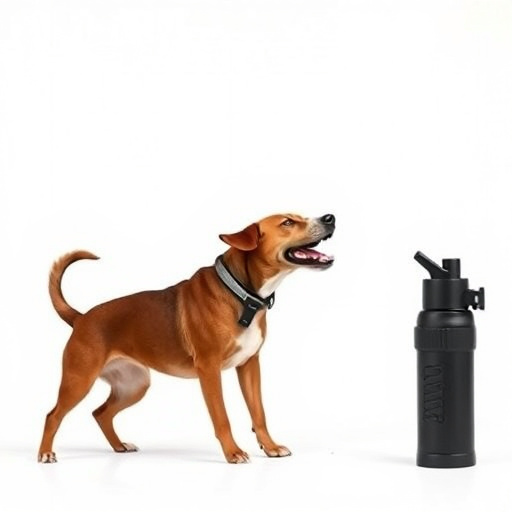Dog aggression requires understanding root causes before considering deterrents like pepper spray, which may not be effective or humane. Behavior modification through training exercises and positive reinforcement is more successful. Dog repellent sprays can complement this process but should never replace education and socialization tailored to each dog's needs. These sprays teach dogs to associate certain scents with negative experiences, helping them learn boundaries. Using capsaicin and citrus oils, they require careful instruction, proper selection, and safety considerations to avoid harm to children and other pets. Positive reinforcement training with repellent spray exercises is an effective, bond-strengthening alternative to chemicals, fostering good manners without harmful chemicals. Regular practice sessions are crucial for consistency and patience.
In many situations, dog attacks can be unpredictable and dangerous. While pepper spray is often touted as a solution, it’s crucial to understand that it might not be the best option for every scenario. This article delves into three key aspects essential for navigating dog aggression. We explore the effectiveness of dog repellent sprays, examining their ingredients and safety concerns. Additionally, we highlight positive reinforcement training exercises as an alternative to pepper spray, fostering better canine behavior through effective training methods.
- Understanding Dog Aggression and Why Pepper Spray Might Not Be the Solution
- Exploring Dog Repellent Sprays: Ingredients, Effectiveness, and Safety
- Training Your Dog with Positive Reinforcement: Alternative to Pepper Spray for Better Behavior
Understanding Dog Aggression and Why Pepper Spray Might Not Be the Solution
Dog aggression is a complex behavior that can stem from various factors, including fear, territorial instincts, or past trauma. Understanding the underlying causes of a dog’s aggression is crucial before considering any form of deterrence, especially pepper spray. While pepper spray may seem like an immediate solution for deterring dog attacks, it is not always the most effective or humane approach.
Training exercises focused on behavior modification and positive reinforcement are often more successful in addressing aggressive tendencies. Dog repellent sprays can be useful as a supplementary tool during training, but they should never replace proper education and socialization. By implementing specific training exercises tailored to an individual dog’s needs, owners can effectively manage aggression and promote a safer environment for both the pet and potential threats.
Exploring Dog Repellent Sprays: Ingredients, Effectiveness, and Safety
Dog repellent sprays are a popular tool for training and managing canine behavior, especially in situations where direct confrontation might be risky or inappropriate. These products are designed to emit an unpleasant scent that can deter dogs from approaching or attacking, giving owners precious time to assess the situation or intervene safely. When exploring dog repellent sprays, understanding the ingredients is key. Many reputable brands use a combination of capsaicin (the active ingredient in chili peppers), citrus oils, and other natural extracts known for their pungent aromas that can repel dogs without causing significant harm.
While effectiveness varies across products due to differences in formulation and concentration, dog repellent sprays have proven successful when incorporated into training exercises. Regular practice with these tools teaches dogs to associate certain scents with a negative experience, helping them learn appropriate boundaries and respond positively to commands. However, safety should never be overlooked. It’s crucial to follow instructions diligently, ensure the spray is suitable for your dog’s age and breed, and keep it out of reach of children and other pets.
Training Your Dog with Positive Reinforcement: Alternative to Pepper Spray for Better Behavior
Training your dog with positive reinforcement is a powerful alternative to using pepper spray for behavior modification. By implementing dog repellent spray training exercises, you can teach your canine companion essential commands and boundaries while strengthening your bond. This method focuses on rewarding desired behaviors, encouraging cooperation, and fostering good manners without resorting to potentially harmful chemicals.
Positive reinforcement training involves using treats, praise, or play as rewards for completing a task or exhibiting the desired behavior. For instance, when teaching “leave it” or “stop,” immediately reward your dog with a tasty treat or enthusiastic praise once they obey. Consistency and patience are key; regular practice sessions will help reinforce these commands and make them second nature to your dog.
While pepper spray may seem like a quick fix for deterring dog attacks, it’s essential to remember that it’s not always effective and can have harmful effects on both dogs and people. A more holistic approach involves understanding canine aggression and employing positive reinforcement training techniques. By combining knowledge of dog behavior with tailored training exercises, owners can create a safer environment for their pets and others without relying on potentially dangerous chemicals. Choosing the right dog repellent spray and using it responsibly, along with consistent training, can significantly improve interactions between dogs and reduce aggressive incidents.
